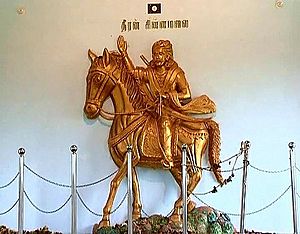Dheeran Chinnamalai facts for kids
Quick facts for kids Dheeran Chinnamalai |
|||||
|---|---|---|---|---|---|
| Pattakarar of Palayakottai Samasthanam, Kangayam Nadu | |||||

Statue of Dheeran Chinnamalai at Odanilai modelled after actor Sivakumar's drawing
|
|||||
| Predecessor | Kongunaadu region | ||||
| Successor | British Rule | ||||
| Born | 17 April 1756 Melapalayam Palayakottai, Kangeyam, Tamil Nadu |
||||
| Died | 31 July 1805 (aged 49) Sankagiri, Salem district, Tamil Nadu, (Madras Presidency) |
||||
| Burial | July/August 1805 Odanilai, Arachalur, Erode district, Tamil Nadu |
||||
|
|||||
| Father | Rathnasamy Gounder | ||||
| Mother | Periyatha | ||||
Dheeran Chinnamalai (born April 17, 1756 – died July 31, 1805) was a brave leader and warrior in India. He was known as a 'Palayakkarar' and 'Pattakarar,' which means he was a local chief or ruler. He fought hard against the British East India Company, a powerful British trading company that was taking control of parts of India.
Contents
Early Life of Dheeran Chinnamalai
Dheeran Chinnamalai was born on April 17, 1756, in a place called Kangeyam. His birth name was Theerthagiri. He came from a respected family.
From a young age, he trained in important skills like sword fighting, archery (using a bow and arrow), and wrestling. These skills helped him become a strong warrior.
He became known as Chinnamalai because he bravely stood up against the government of Mysore. This government was collecting taxes in the Kongu region. Chinnamalai stopped them from collecting these taxes between Chennimalai and Sivanmalai.
Fighting the British: The Polygar Wars
Dheeran Chinnamalai joined forces with Tipu Sultan, the King of Mysore. Their goal was to protect India from the British. Chinnamalai and Tipu Sultan had great success in three battles against the British in Mysore.
The British were very angry about these defeats. After fighting alongside Tipu Sultan, Chinnamalai returned to his home in Odanilai. He built a strong fort there after Tipu Sultan passed away.
Chinnamalai was an important commander in the Polygar Wars. These were a series of wars where local Indian chiefs fought against the British. He played a key role in the Second Polygar War from 1801 to 1802.
After the deaths of other brave leaders like Kattabomman and Tipu Sultan in 1799, Chinnamalai continued the fight. He sought help from other leaders like Dhondia Wagh and Maruthu Pandiyar. He also led many local chiefs, known as Pattakarars, from his region.
In 1800, Chinnamalai and his allies planned to attack the British in Coimbatore. However, the British forces managed to stop some of the allied armies. So, Chinnamalai had to attack Coimbatore with the local chiefs from the Kongu Nadu region. His army was defeated, and he had to escape from the British.
Chinnamalai then used a special fighting style called guerrilla warfare. This means fighting in small groups, using surprise attacks, and knowing the land very well. Using this method, he defeated the British in several battles:
- At the Cauvery River in 1801.
- At Odanilai in 1802.
- At Arachalur in 1804.
Death of a Hero
Dheeran Chinnamalai was captured by the British. He was executed at Sankagiri Fort on July 31, 1805. His two brothers were also executed on the same day.
Legacy of Dheeran Chinnamalai
Dheeran Chinnamalai is remembered as a great freedom fighter.
- Statues and memorials have been built to honor him in cities like Chennai, Tiruchirappalli, Erode, and Odanilai.
- On July 31, 2005, India Post released a special postage stamp to remember him.
- The main office building for the Erode district collectorate is named after him.
- The main office of the Erode Municipal Corporation is also named in his honor.



